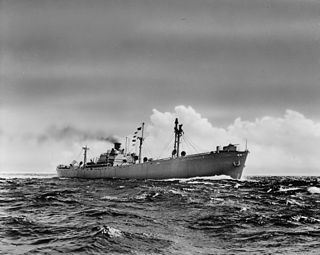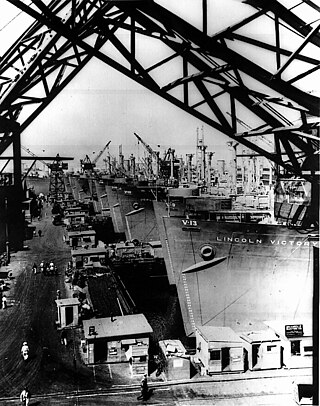
The SS Lindenwood Victory was a Victory-class cargo ship built during World War II. The Lindenwood Victory was a type VC2-S-AP2 victory ship built by Permanente Metals Corporation, Yard 2, of Richmond, California. The Maritime Administration cargo ship was the 766th ship built. Her keel was laid on May 12, 1945. SS Lindenwood Victory was an armed cargo ship She was built in just 70 days, under the Emergency Shipbuilding program for World War II. SS Lindenwood Victory was an armed cargo ship, named for Lindenwood University in St. Charles, Missouri, one of 150 educational institutions that had Victory ships named after them. The 10,600-ton ship was constructed for the Maritime Commission.

The SS Carroll Victory was the twenty-seventh Victory ship built during the World War II under the Emergency Shipbuilding program. shewas launched by the California Shipbuilding Company on June 13, 1944, and completed on August 31, 1944. The ship was named after Carroll, Iowa. The ship’s United States Maritime Commission designation was VC2-S-AP3 with a hull number 27 (V-27). shewas operated by the Lykes Brothers Steamship Company and sheserved in the Atlantic Ocean during World War II. The Carroll was one of the new 10,500-ton class ship known as Victory ships that were designed to replace the earlier Liberty Ships. Unlike Liberty ships, Victory ships were designed to last longer and serve the US Navy after the war. The Victory ships differed from Liberty ships in that they were faster, longer and wider, taller, had a thinner stack set farther toward the superstructure, and had a long raised forecastle.

The SS Cody Victory was a Victory ship (VC2-S-AP3) built during World War II under the Emergency Shipbuilding program. The ship's keel was laid by the California Shipbuilding Company as hull number 69 on 26 October 1944 with launch on 12 December 1944. The ship was completed on 22 January 1945. On completion the ship, U.S. Official Number 247094, was delivered to the War Shipping Administration for operation by the Alcoa Steamship Company as agent.

The SS Coeur d'Alene Victory was a Victory ship built during World War II under the Emergency Shipbuilding program. She was launched by the Oregon Shipbuilding Corporation on December 15, 1944, completed on January 12, 1945. The ship's United States Maritime Commission designation was VC2-S-AP3, hull number 153 (1207). The Maritime Commission turned her over to a civilian contractor, the Isbrandtsen Steamship Company, for operation under the War Shipping Administration.

The SS Colgate Victory was the Second of 153 Victory ships built during World War II. She was launched by the Oregon Shipbuilding Corporation on December 15, 1944, completed on January 12, 1945. The ship's United States Maritime Commission designation was VC2-S-AP3, hull number 170 (1224) (MCV-170). The Maritime Commission turned her over to a civilian contractor, Pacific-Atlantic SS Company, for operation.

The SS United States Victory was the fourth Victory ship built during World War II under the Emergency Shipbuilding program. She was launched by the California Shipbuilding Company on March 6, 1944 and completed on April 30, 1944. The ship’s United States Maritime Commission designation was VC2- S- AP3, hull number 3 (V-3). SS United States Victory served in the Pacific Ocean during World War II. The 10,500-ton Victory ships were designed to replace the earlier Liberty Ships. Liberty ships were designed to be used just for World War II. Victory ships were designed to last longer and serve the US Navy after the war. The Victory ship differed from a Liberty ship in that they were: faster, longer and wider, taller, had a thinner stack set farther toward the superstructure and had a long raised forecastle.

The SS Philippines Victory was the fifth Victory ship built during World War II. She was launched by the California Shipbuilding Company on March 11, 1944, and completed on May 9, 1944. She was built in 113 days under the Emergency Shipbuilding program.

The SS New Zealand Victory was the sixth Victory ship built during World War II. She was launched at Terminal Island by the California Shipbuilding Company on March 20, 1944 and completed on May 13, 1944. She was built in 109 days under the Emergency Shipbuilding program. The ship’s United States Maritime Commission designation was VC2-S-AP3, hull number 6 (V-6). SS New Zealand Victory served in the Pacific Ocean during WW2. SS New Zealand Victory was sixth of the new 10,500-ton class ship to be known as Victory ships. Victory ships were designed to replace the earlier Liberty Ships. Liberty ships were designed to be used just for WW2. Victory ships were designed to last longer and serve the US Navy after the war. The Victory ship differed from a Liberty ship in that they were: faster, longer and wider, taller, a thinner stack set farther toward the superstructure and had a long raised forecastle.

The SSPanama Victory was a Victory ship built during World War II. She was launched by the California Shipbuilding Company on April 3, 1944 and completed on May 30, 1944. She was built in 115 days under the Emergency Shipbuilding program. The ship’s United States Maritime Commission designation was VC2-S-AP3, hull number 9 (V-9). SS Panama Victory served in the Pacific Ocean during World War II. SS Panama Victory was ninth of the new 10,500-ton class ship to be known as Victory ships. Victory ships were designed to replace the earlier Liberty Ships. Liberty ships were designed to be used just for WW2. Victory ships were designed to last longer and serve the US Navy after the war. The Victory ship differed from a Liberty ship in that they were: faster, longer and wider, taller, had a thinner stack set farther toward the superstructure and had a long raised forecastle. Engine was made by Joshua Hendy Iron Works Inc. of Sunnyvale, California.

SS Hagerstown Victory was a Victory ship-based troop transport built for the U.S. Army Transportation Corps (USAT) late in World War II under the Emergency Shipbuilding program. It saw service in the European Theater of Operations during 1945 and in the immediate post-war period repatriating U.S. troops. Hagerstown Victory was one of 97 cargo Victory ships converted to a troopship.

The SS Baton Rouge was a cargo Victory ship built during World War II under the Emergency Shipbuilding program. The Baton Rouge (MCV-846) was a type VC2-S-AP2 Victory ship built by Bethlehem-Fairfield Shipyards. The Maritime Administration cargo ship was the 846rd ship built. Her keel was laid on June 21, 1945. She was launched on August 22, 1945, and completed on September 24, 1945. The 10,600-ton ship was constructed for the Maritime Commission. The American Export Line and later the Isthmian Steamship Company operated her under the United States Merchant Marine act for the War Shipping Administration.

SS New Bern Victory was a cargo Victory ship built during World War II under the Emergency Shipbuilding program. The New Bern Victory (MCV-639) was a type VC2-S-AP2 Victory ship built by Bethlehem-Fairfield Shipyards. The Maritime Administration cargo ship was the 639 ship built. Her keel was laid on January 15, 1945. She was launched on March 8, 1945 and completed on March 31, 1945. The 10,600-ton ship was constructed for the Maritime Commission. The American Export Line and later the Isthmian Steamship Company operated her under the United States Merchant Marine act for the War Shipping Administration. Named for the city of New Bern, North Carolina.

SS Attleboro Victory was a Victory ship built for the War Shipping Administration late in World War II under the Emergency Shipbuilding program. It saw service in the European Theater of Operations in the Atlantic Ocean during 1945, and in the immediate post-war period. Attleboro Victory was part of the series of Victory ships named after famous cities. This particular ship was named after the city of Attleboro, Massachusetts. It was a type VC2-S-AP2/WSAT cargo ship with the United States Maritime Commission (MCV) -"Victory"; hull number 642, shipyard number 1597 and built by Bethlehem Shipbuilding Corporation in Baltimore, Maryland. Phyllis O'Neil of Attleboro, Massachusetts christened Attleboro Victory with a champagne bottle.

SS India Victory was a Victory ship built and operated as a cargo carrier and troopship in World War II. After the war the ship was used a private cargo ship. She sank on 12 July 1972, ran aground on a Pratas Reef in the South China in Typhoon Susan.

USNS Victoria (T-AK-281) was a Norwalk-class fleet ballistic missile cargo ship, which was launched as a World War II commercial Victory cargo ship SS Ethiopia Victory under the Emergency Shipbuilding program. The Ethiopia Victory was acquired by the U.S. Navy in 1963.

SS Augustana Victory was built and operated as Victory ship class cargo ship which operated as a cargo carrier in World War II, and Vietnam War.

SS Fordham Victory was built and operated as Victory cargo ship which operated as a cargo carrier in World War II. For the war she was operated by the Weyerhaeuser Steamship Company under charter with the Maritime Commission and War Shipping Administration.

The SS Tufts Victory was a class of Victory ship built during World War II under the Emergency Shipbuilding program. She was launched by the California Shipbuilding Company on 2 March 194. The ship was completed and delivered to the wartime operator of all United States oceangoing shipping, the War Shipping Administration (WSA), on 28 March 1945. Tufts Victory, official number 247512, was assigned to American Mail Line, under a standard WSA operating agreement at that time. That agreement continued until the ship's sale in 1947. The ship's United States Maritime Commission designation was VC2-S-AP3, hull number 771. Tufts Victory was converted from a cargo ship to a troopship to bring troops home after the war as part of Operation Magic Carpet.

The SS Alamo Victory was the 42nd Victory ship built during World War II under the Emergency Shipbuilding program. She was launched by the California Shipbuilding Company on July 13, 1944, and completed on August 18, 1944. The ship’s United States Maritime Commission designation was VC2- S- AP3, hull number 42 (V-32), she worked as merchant marine for all of her career. SS Alamo Victory served in the Pacific Ocean during World War II and was operated by the Isthmian Steamship Company. The 10,500-ton Victory ships were designed to replace the earlier Liberty Ships. Liberty ships were designed to be used just for World War II. Victory ships were designed to last longer and serve the US Navy after the war. The Victory ship differed from a Liberty ship in that they were: faster, longer and wider, taller, had a thinner stack set farther toward the superstructure, and had a long raised forecastle.

SS Skagway Victory was a Victory ship built for the United States during World War II. She was launched by the Oregon Shipbuilding Corporation on June 21, 1944, and was completed on July 15, 1944. The ship's US Maritime Commission designation was VC2-S-AP3, hull number 116 (V-116). She was built in 64 days under the Emergency Shipbuilding program. The Maritime Commission turned her over to a civilian contractor, the Alcoa, for operation until the end of World War II hostilities. She was operated under the US Merchant Marine Act for the War Shipping Administration.








